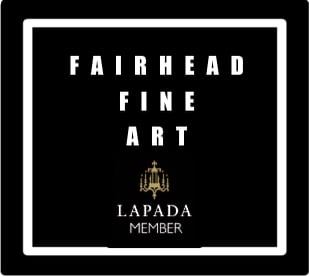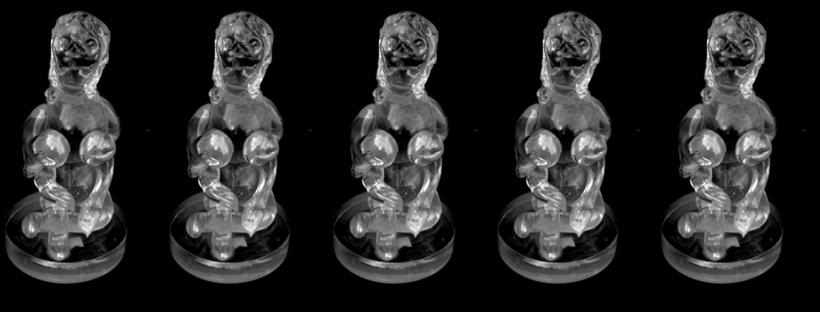Fucina degli Angeli / Egidio Costantini
This project began as an artist's cooperative in 1950, Centro Studi Pittori Arte del Vetro, set up by Egidio Costantini, Fioravante Seibezzi, Armando Tonello, Gino Krayer, Mario Carraro, Aldo Bergamini, and others, with the intent of having a permanent place of business and showroom in Murano. Technical affairs were initially cared for by the maestro Aldo Bon, known as "Polo", who instructed the painters in the potential of expression offered by glassware.
The first show was held in Murano on 18 April 1953 with works by Guidi, Calder, Moore, Le Corbusier, Kokoschka. One year later the Centro changed its name to Fucina degli Angeli, on the suggestion of Jean Cocteau.
From that point on it was just one exhibition after the other: Basel, Paris, New York. Through Costantini's actvities, many artists worked with glass, including Andersen, Arp, Bodmer, Braque, Cagli, Calder, Chagall, Dall'Acqua, Dova, Ernst, Fontana, Guidi, Guttuso, Hundertwasser, Kokoschka, Le Corbusier, Leger, Lewitt, Licata, Minguzzi, Novati, Picasso, Ponti, Tobey.
It is actually Jean Arp who designed the symbol of the Fucina itself. The works were executed with the assistance of the greatest glassworks, by the best master glassblowers, such as: Aldo "Polo" Bon, Albino Carrara, Luciano Ferro, Gino Fort, Francesco Martinuzzi, Aldo Nason, Archimede Seguso, Angelo Tosi and Ferdinando Toso.
Peggy Guggenheim, had a primary role in the creation of the Fucina. It was thanks to her that a great many prestigious names in the world of art got in touch with Costantini and it was through her introduction that the Museum of Modern Art in New York organized in 1965 a large exhibition of glass sculptures. Her innate sense of artistic patronage made her part directly in the initiative, subsidizing the Fucina through a fifty percent corporate contract. In 1966 it was thus possible to open the new showroom at Castello 4463 (Venice, Italy), its place of business to this day, after a careful restoration in the late 80s.
Commercial relationships between the artists and Costantini were regulated by an agreement that provided for three copies of each work to be made, one of which was to be sold and the revenue split, one would go to the artist and the third remained with the Fucina. But, at a later date, conflicts and the objections arose, especially as to the real paternity of the works, so a different way was chosen.
If we look at the exhibition catalogues of the Fucina after the 70s, the works are all attributed as follows: "Each original work is executed and interpreted by Egidio Costantini on the study, design, maquette or idea by the artists". It is obvious that such a definition can be variously considered in relation to the real role played by each individual artist: the attribution of the true paternity of each item was thus extrtemely delicate, about the importance of the names involved and the corresponding ups and downs of quotations, even in purely financial terms.
Egidio Costantini, was a man about whom many good and many badthings have been said. A favourite of powerful people, He was often acclaimed and later hounded by the critics. he di, however, in over forty years of activity constitute something unique. He created all round the world of Murano glass such a movement of ideas, opinions and research, made by llustrious and brilliant people. The history of glassware in The 20th century owes something to him.
The cover piece --a glass sculpture by Costantini-- can be seen here:
https://www.fairheadfineart.com/store?productlist-categories=egidio-costantini
The first show was held in Murano on 18 April 1953 with works by Guidi, Calder, Moore, Le Corbusier, Kokoschka. One year later the Centro changed its name to Fucina degli Angeli, on the suggestion of Jean Cocteau.
From that point on it was just one exhibition after the other: Basel, Paris, New York. Through Costantini's actvities, many artists worked with glass, including Andersen, Arp, Bodmer, Braque, Cagli, Calder, Chagall, Dall'Acqua, Dova, Ernst, Fontana, Guidi, Guttuso, Hundertwasser, Kokoschka, Le Corbusier, Leger, Lewitt, Licata, Minguzzi, Novati, Picasso, Ponti, Tobey.
It is actually Jean Arp who designed the symbol of the Fucina itself. The works were executed with the assistance of the greatest glassworks, by the best master glassblowers, such as: Aldo "Polo" Bon, Albino Carrara, Luciano Ferro, Gino Fort, Francesco Martinuzzi, Aldo Nason, Archimede Seguso, Angelo Tosi and Ferdinando Toso.
Peggy Guggenheim, had a primary role in the creation of the Fucina. It was thanks to her that a great many prestigious names in the world of art got in touch with Costantini and it was through her introduction that the Museum of Modern Art in New York organized in 1965 a large exhibition of glass sculptures. Her innate sense of artistic patronage made her part directly in the initiative, subsidizing the Fucina through a fifty percent corporate contract. In 1966 it was thus possible to open the new showroom at Castello 4463 (Venice, Italy), its place of business to this day, after a careful restoration in the late 80s.
Commercial relationships between the artists and Costantini were regulated by an agreement that provided for three copies of each work to be made, one of which was to be sold and the revenue split, one would go to the artist and the third remained with the Fucina. But, at a later date, conflicts and the objections arose, especially as to the real paternity of the works, so a different way was chosen.
If we look at the exhibition catalogues of the Fucina after the 70s, the works are all attributed as follows: "Each original work is executed and interpreted by Egidio Costantini on the study, design, maquette or idea by the artists". It is obvious that such a definition can be variously considered in relation to the real role played by each individual artist: the attribution of the true paternity of each item was thus extrtemely delicate, about the importance of the names involved and the corresponding ups and downs of quotations, even in purely financial terms.
Egidio Costantini, was a man about whom many good and many badthings have been said. A favourite of powerful people, He was often acclaimed and later hounded by the critics. he di, however, in over forty years of activity constitute something unique. He created all round the world of Murano glass such a movement of ideas, opinions and research, made by llustrious and brilliant people. The history of glassware in The 20th century owes something to him.
The cover piece --a glass sculpture by Costantini-- can be seen here:
https://www.fairheadfineart.com/store?productlist-categories=egidio-costantini

